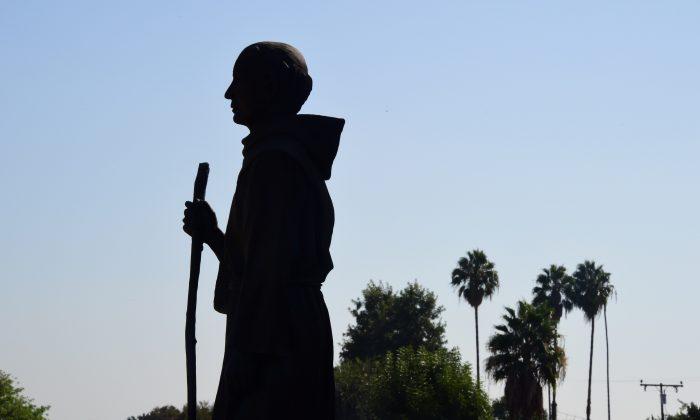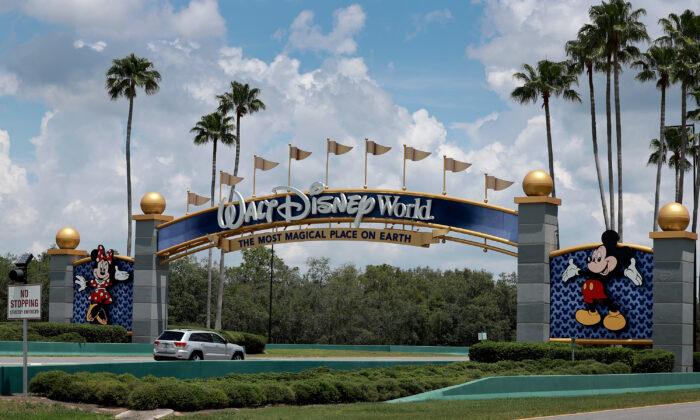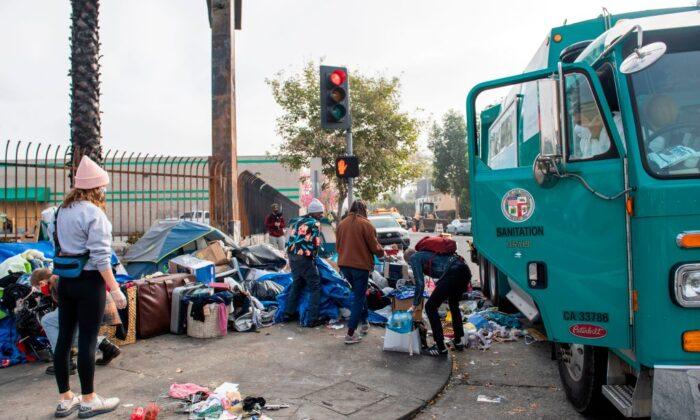On Oct. 12, 2020, a group of Indigenous Peoples’ Day protesters entered the grounds of the Mission San Rafael Arcángel, a historic California mission about 20 miles north of San Francisco that’s now part of the Catholic parish of St. Raphael in Marin County.
During the course of the protest some of the 50 or so activists present pulled down a six-foot statue of Junípero Serra, the 18th-century Franciscan priest who had founded California’s mission system when California was under Spanish rule. Serra was canonized a saint by Pope Francis in 2015, but among California’s progressives he has become a symbol of European colonization and enslavement of the Native Americans the missions sheltered and served.
The statue-topplers had come prepared, bringing with them nylon rope and red paint. They used the rope to drag the statue to the ground, peeled off a layer of duct tape with which the mission’s employees had hoped to protect it, and defaced it with the paint, which presumably symbolized blood. They covered the statue’s base with graffiti.
Eventually five people (all of whom seem to be Native American women, although at least one identifies as “Two Spirit”), allegedly caught on video pitching the statue, were arrested and in February formally charged with felony vandalism. Since then, however, there has been a relentless campaign, spearheaded by the National Lawyers Guild, to persuade Marin County District Attorney Lori Frugoli to drop the charges against the Indigenous Peoples Five, as they now call themselves.
Some 80,000 people have signed a Change.org petition to that effect. The petition calls Serra “a notoriously violent mission system leader” and implies that the mission was the guilty party in the incident because of the “violence” of its founding on land “stolen” from indigenous peoples.
This was not the only destruction of a statue of Serra in California in what amounts to an outright war against the friar by protesters claiming to represent the interests of Native Americans. On June 19, 2020, activists toppled and smeared red paint onto a 30-foot bronze statue of the saint that had stood in San Francisco’s Golden Gate Park for more than a century.
The next day, June 20, tribal protesters in Los Angeles knocked down a nine-foot statue of the saint that had stood since 1932 in Father Serra Park near the site of the first Spanish settlement in the city’s downtown (it was a copy of a statue of Serra that the state placed in the U.S. Capitol in 1931). The Los Angeles City Council deemed the action an act of “civil disobedience,” and no one was prosecuted.
On July 4, demonstrators ripped down a statue of Serra in Sacramento’s Capitol Park, again without any effort being made to catch them, much less to bring charges (a bill pending in the California Legislature would replace the statue with a monument honoring Native Americans). On July 15, the Ventura City Council voted to remove two Serra statues from public places.
Earlier, in 2018, Stanford University administrators, reacting to campus protesters, had voted to remove Serra’s name from the campus mall and two campus buildings. Stanford planned to change Serra Mall to “Jane Stanford Way.” This was ironic, because Jane Stanford, who with her husband, the railroad magnate Leland Stanford, had founded the university in 1885, was one of Serra’s most fervent admirers. In 1891, she had commissioned the erection of a statue of him in a park at Monterey, where he had first arrived in California in 1768 after serving as a missionary in Mexico for 18 years. That statue was decapitated by a sledgehammer in 2015, but the head was found and reattached two years later. It seems to be one of the few outdoor statues of Serra that is still permitted to stand.
The Californian war against Junípero Serra isn’t simply a war of leftist activists, abetted by politicians in this overwhelmingly blue state, against former generations of Californians who romanticized the missions and their padres (Helen Hunt Jackson’s hugely popular 1884 novel “Ramona” is an example of this). Nor is it simply a war against Christianity and its elevation to sainthood of a man they believe helped destroy Native American culture by converting Native Americans to Catholicism. It is a war against California history itself.
Indeed, Junípero Serra could be said to have invented the state of California. The missions that he and his successors founded were the vertebrae along the spine of the El Camino Real (pretty much coterminous with U.S. 101), which runs along the California coast. Every major city in California—San Diego, Santa Ana, Los Angeles (near Mission San Gabriel), San Jose, San Francisco—lies on the mission trail.
Serra and his successors introduced vineyards, cattle, and olive trees to California agriculture, and were responsible for the state’s distinctive “mission” style of architecture: the stucco-coated walls and red-tiled roofs that are ubiquitous in the state.
University of California–Riverside professor Steven W. Hackel, in his prizewinning 2014 biography of Serra, calls him “California’s founding father.” Hackel doesn’t romanticize Serra, whose missions’ worst failing, he writes, was that they decimated the native population by exposing it to fatal European diseases. But he also focuses on Serra’s intense and genuine religious devotion and his tireless war against the Spanish military and secular authorities who thought little of the Indians except as candidates for exploitation.
Mission San Rafael, founded in 1817 by one of Serra’s successors, started as a hospital for sick Native Americans. Serra deserved in every way the many statues of him in California, the statues that current-day activists, who have no understanding of history, seek to destroy in every way they can.





